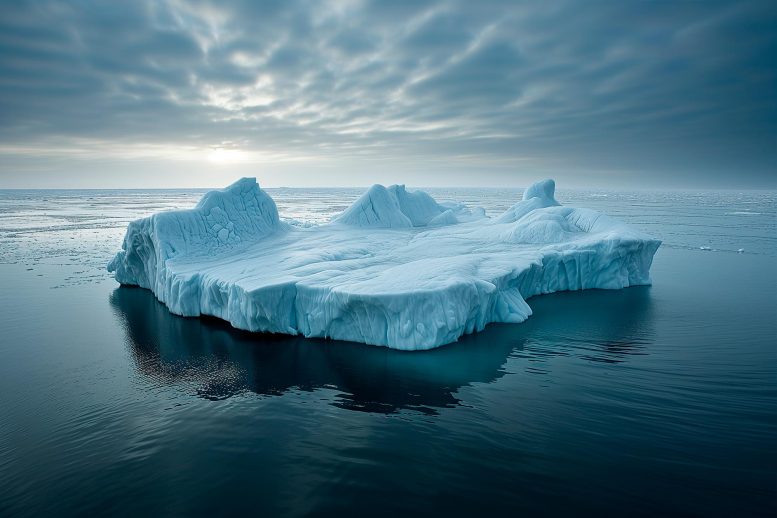
A new study on the 79° N-Glacier in Greenland shows a significant reduction in ice thickness due to warming oceans and atmospheric conditions. The findings reveal a 32% thinning of the glacier since 1998 and the formation of large underwater channels. Despite a recent slowdown in melt rates, the glacier is expected to disintegrate in the coming years, underlining the urgent need for detailed research on these changes.
Under the 79° N-Glacier, melt rates have been measured at 130 meters per year.
Measurements from land-based instruments and airplane-mounted radars in Greenland’s far northeast reveal the extent of ice loss experienced by the 79° N-Glacier. The Alfred Wegener Institute’s findings indicate that the glacier’s thickness has reduced by over 160 meters since 1998. This significant decrease is primarily due to warm ocean currents that are melting the glacier from below.
High air temperatures cause lakes to form on the surface, whose water flows through huge channels in the ice into the ocean. One channel reached a height of 500 meters, while the ice above was only 190 meters thick, as a research team has now reported in the scientific journal The Cryosphere.
A rustic camp in northeast Greenland was one of the bases for deploying autonomous measuring devices with modern radar technology by helicopter in a part of the 79° N-Glacier that is difficult to access. Measurement flights with the polar aircraft of the Alfred Wegener Institute, Helmholtz Centre for Polar and Marine Research (AWI), and satellite data were also incorporated into a scientific study that has now been published in the scientific journal The Cryosphere.

Ole Zeisig starting pRES (radar) measurement on 79 North Glacier. Credit: Alfred Wegener Institute / Niklas Neckel
This study examines how global warming affects the stability of a floating ice tongue. This is of great importance for the remaining ice shelves in Greenland as well as those in Antarctica, as instability of the ice shelf usually results in an acceleration of the ice flow, which would lead to a greater sea level rise.
Glacier Changes and Observations
“Since 2016, we have been using autonomous instruments to carry out radar measurements on the 79° N-Glacier, from which we can determine melt and thinning rates,” says AWI glaciologist Dr Ole Zeising, the first author of the publication. “In addition, we used aircraft radar data from 1998, 2018, and 2021 showing changes in ice thickness. We were able to measure that the 79° N-Glacier has changed significantly in recent decades under the influence of global warming.”
The study shows how the combination of a warm ocean inflow and a warming atmosphere affects the floating ice tongue of the 79° N-Glacier in northeast Greenland. Only recently, an AWI oceanography team published a modeling study on this subject. The unique data set of observations now presented shows that extremely high melt rates occur over a large area near the transition to the ice sheet. In addition, large channels form on the underside of the ice from the land side, probably because the water from huge lakes drains through the glacier ice. Both processes have led to a strong thinning of the glacier in recent decades.
Due to extreme melt rates, the ice of the floating glacier tongue has become 32 % thinner since 1998, especially from the grounding line where the ice comes into contact with the ocean. In addition, a 500-meter-high channel has formed on the underside of the ice, which spreads towards the inland. The researchers attribute these changes to warm ocean currents in the cavity below the floating tongue and to the runoff of surface meltwater as a result of atmospheric warming. A surprising finding was that melt rates have decreased since 2018. A possible cause for this is a colder ocean inflow. “The fact that this system reacts on such short time scales is astonishing for systems that are actually inert such as glaciers,” says Prof Dr Angelika Humbert, who is also involved in the study.
“We expect that this floating glacier tongue will break apart over the next few years to decades,” explains the AWI glaciologist. “We have begun to study this process in detail to gain maximum insight into the course of the process. Although there have been several such disintegrations of ice shelves, we have only been able to collect data subsequently. As a scientific community, we are now in a better position by having built up a really good database before the collapse.”
Reference: “Extreme melting at Greenland’s largest floating ice tongue” by Ole Zeising, Niklas Neckel, Nils Dörr, Veit Helm, Daniel Steinhage, Ralph Timmermannand and Angelika Humbert, 22 March 2024, The Cryosphere.
DOI: 10.5194/tc-18-1333-2024









Be the first to comment on "160-Meter Thaw: Scientists Uncover Enormous Ice Loss From Greenland Glacier"